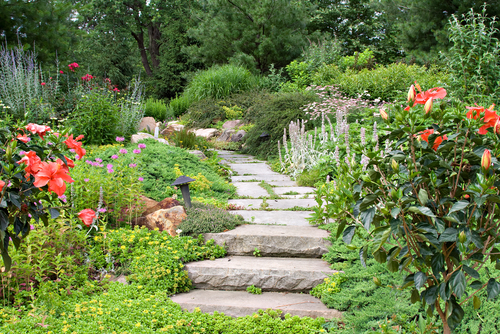Darin Engh, from Engh Gardens shares some tips on how to create a successful invitation to your home.
Put your imagination in charge of your front yard landscaping, and you’ll transform even the most humdrum space into a welcoming, blooming paradise. Start with your front walk. To make a short yard seem longer, build a winding path. Establish a strong focal point at both ends of the walkway with shrubs or mounding perennials. Dwarf conifers, or clumps of ornamental grasses will provide interest. Whether your front yard is spacious or small, you can dazzle your visitors and satisfy your gardening soul with plantings full of flowers. An entry walk can link the driveway and the front door, and draw attention away from so much bare pavement. If a perfectly straight entry walk is the best choice for your landscape, it doesn’t have to look like a package ribbon tied across the yard. Curving beds can hold relaxed plantings of shrubs and perennials, arranged in outward sweeping drifts that de-emphasize the underlying severity. Plants that are mounding, billowing, or spreading, offer a soft contrast to the straight walk.
“The problem is that our notion of the quality of life ends at our front door,” design the same quality of life you have inside your home out to the property line. Create a moat of grace. Don’t just have the bare necessities for a path in your front yard, have paths that allow you to circulate your entire property.
TIPS
1- Front door pathways should accommodate two people walking abreast; five feet is ample.
2- Front yard paths, not leading to a door, can be three feet wide.
3- A small maintenance path, infrequently used, can be a one foot stepping stone.
4- Function should dictate where pathways should go.
5- View your pathways from multiple perspectives to help you add pleasing form.
6- An entry garden sets your house into the landscape, into a garden.
7- The front of your house holds many cues as to the style of your new entry garden.
8- Straight paths feel more formal than curving paths.
9- The path itself is where you begin to design your garden, get the path right and your garden will flow with it.
10- Straight paths are forceful, assertive, firm elements in the landscape that often relate better to the geometry of a house than curving paths do.
11- Curving paths need to curve in broad, simple ways. Curving paths often enable you to screen unsightly views and they also help you build mystery along the way.
12- Curves in entry paths are good places for fragrant plants. As people walk the curve, they brush against the fragrant leaves or flowers to release the aroma.
13- Paths can help you choose plants: low plants along the edges, with plants getting taller as you move away from the path. The entrance to a path is an appropriate place for a tree or shrubs to mark the entrance.
For more ideas and plant suggestions, you can visit Darin at Engh Gardens in Sandy or online at www.enghgardens.com .















Add comment